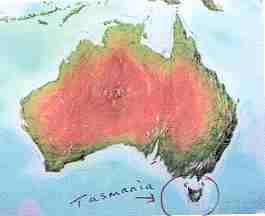
Oh no, it's a fox!
The first day of August was a bad day for Tasmanians. The discovery of a fox carcass confirmed that the red fox, the bane of native Australian wildlife (not to mention graziers) on the mainland for over a century, had indeed established itself in the island state about the same size as West Virginia. Few people, Australian or otherwise, are aware of just how much ecological ruin two introduced species of mammal — the red fox and the rabbit — have wrought in Australia in less than 200 years. Nobody can estimate with accuracy just what the cost has been to the Australian economy, but it would probably reach billions of dollars annually.
Just how much impact these two species have had on wildlife is impossible to say. However, Australia has the worst record for extinction of mammal species in modern history, and the fox in particular is probably the chief culprit. Until now, small native Tasmanian mammals such as bandicoots, echidnas, quolls and possums have flourished compared with their mainland compatriots. Who knows what will become of them, and many ground-dwelling birds, in the future?
Yes, I know that animals have no hope of salvation, and we must not put a premium on the value of animals anywhere near as high as that on human beings who are made in the image of God, and who have hope of eternal life in the kingdom of God. But God saw fit to design every creature on earth, and He saw fit to enrich human life and enhance our economic welfare by providing us with birds and animals to bring joy to human hearts and to provide us with food and clothing. The loss of any animal or plant species is a cause for regret; the wholesale destruction over the centuries of untold numbers of species by human beings, sometimes using introduced animals as their agent, should horrify us all. Scripture tells us that God holds us accountable for our attitude towards the world — and its inhabitants — that we call home (Rev. 11:18).
Our track record is abominable. Many of the 47 commercial fish species that once thrived in the Nile River have disappeared (National Geographic, January 1997, p. 4). Europe's cave bears, the great auk, the dodo, Steller's sea cow, the Tasmanian tiger, New Zealand's elephant bird and its relatives, Hawaiian birds too numerous to mention and… and… on and on it goes — dead, gone, caput, extinct. And all because of human negligence or greed. How is it possible that the most populous bird in North America at one time, the passenger pigeon, has vanished from the skies?
I'm going to cheat, and quote extensively |
from Bill Bryson's book “A Walk in the Woods". His words bring tears to my eyes. Speaking about the changes taking place in American woods in the early nineteenth century, he says,
The panthers, elk and timberwolves were being driven to extinction, the beaver and bear nearly so. The great first-growth white pines of the north woods, some of them 220 feet high — that's the height of a twenty-storey building — had mostly been felled to make ship's masts or simply cleared away for farmland, and nearly all the rest would go before the century was out. Everywhere there was a kind of recklessness born of a sense that the American woods were effectively inexhaustible. Two-hundred-year old pecan trees were commonly chopped down just to make it easier to harvest the nuts on their topmost branches. With each passing year the character of the woods changed perceptibly. But until quite recent times… one thing remained in abundance that preserved the primeval super-Eden feel of the original forest: the massively graceful American chestnut.
There has never been a tree like it. Rising a hundred feet from the forest floor, its soaring boughs spread out in a canopy of incomparable lushness, an acre of leaves per tree, a million or so in all… At ground level, a full-sized tree would be 10 feet through its bole, more than 20 feet around. I have seen a photograph, taken at the start of this century, of people picnicking in a grove of chestnuts… the ladies with clasped parasols, the men with bowler hats and walrus moustaches, all handsomely arrayed on a blanket in a clearing, against a backdrop of steeply slanting shafts of lights and trees of unbelievable grandeur. The people are so tiny, so preposterously out of scale to the trees around them, as to make you wonder for a moment if the picture has been manipulated as a kind of joke, like those old postcards that show watermelons as big as barns… But this is simply the way it was — the way it was over tens of thousands of square miles of hill and cove, from the Carolinas to New England. And it is all gone now.
I don't know about you, but I could get very depressed, extremely depressed, when I think about such things were it not for one fact — Scripture shows that God is going to heal the planet:
And it shall be that every living thing that moves, wherever the rivers go, will live. There will be a very great multitude of fish, because these waters go there; for they will be healed , and everything will live wherever the river goes (Ez. 47:9).
I know this verse doesn't say it explicitly, but I believe it implies strongly that extinct creatures will be restored. The river will flow into the sea and heal it; the sea's waters will evaporate and fall on the land and heal it. With all my heart I say, “Thank you, God”. I only hope I will be there to see it happen. Wouldn't you like to, too? |
![]()
![]()
![]()